NACA 0012 Low Speed Airfoil#
Introduction#
The purpose of this case study is to verify and validate the functionality of the Flow360 solver and the implementation of the Spalart-Allmaras (SA) and Menter’s
In this study, Reynolds-averaged Navier-Stokes (RANS) simulations utilizing the SA and the SST turbulence models were performed at the same operating conditions as given on those webpages. According to these major conclusions: 1st, the trailing edge streamwise spacing has profound influence on the airfoil lift and moment results, and the grid of Family II yields the most accurate results; 2nd, numerical schemes incorporated with 2nd-order accuracy for turbulence advection are desirable for better asymptotic grid convergence; in the current validation cases, the grid of Family II at Level-4 and 2nd-order accuracy for turbulence model equation were utilized. This grid resolution is comparable to that used in the reference validation cases. Current numerical results were validated with respect to available experimental data, as well as other CFD results where appropriate.
Mesh and Flow Configuration#
From the three series of nested grids with varying trailing edge streamwise spacing, available from this NASA webpage, we used the grid of Family II at Level-4 (FMLY2GL4, with a grid resolution of 897 x 2 x 257) for this validation. The geometry and the mesh of this quasi-3D CFD model are shown in Fig. 16. As seen, the grid has a C-type topology, wrapping around the airfoil from the downstream farfield, around the lower surface to the upper, then back to the downstream farfield again. Also, in the wake region, the grid connects to itself in a point-matched manner. The chord length is scaled to unity, and the grid unit is taken to be meter. The origin of the grid coordinates is at the leading edge of the airfoil. The x-axis is in alignment with the chord line. Also, the grid is stretched for one spanwise cell in the negative y direction with the grid spacing of one unit length. For this validation case, the original NASA grids are converted from ADF to HDF5 data format and are available here.
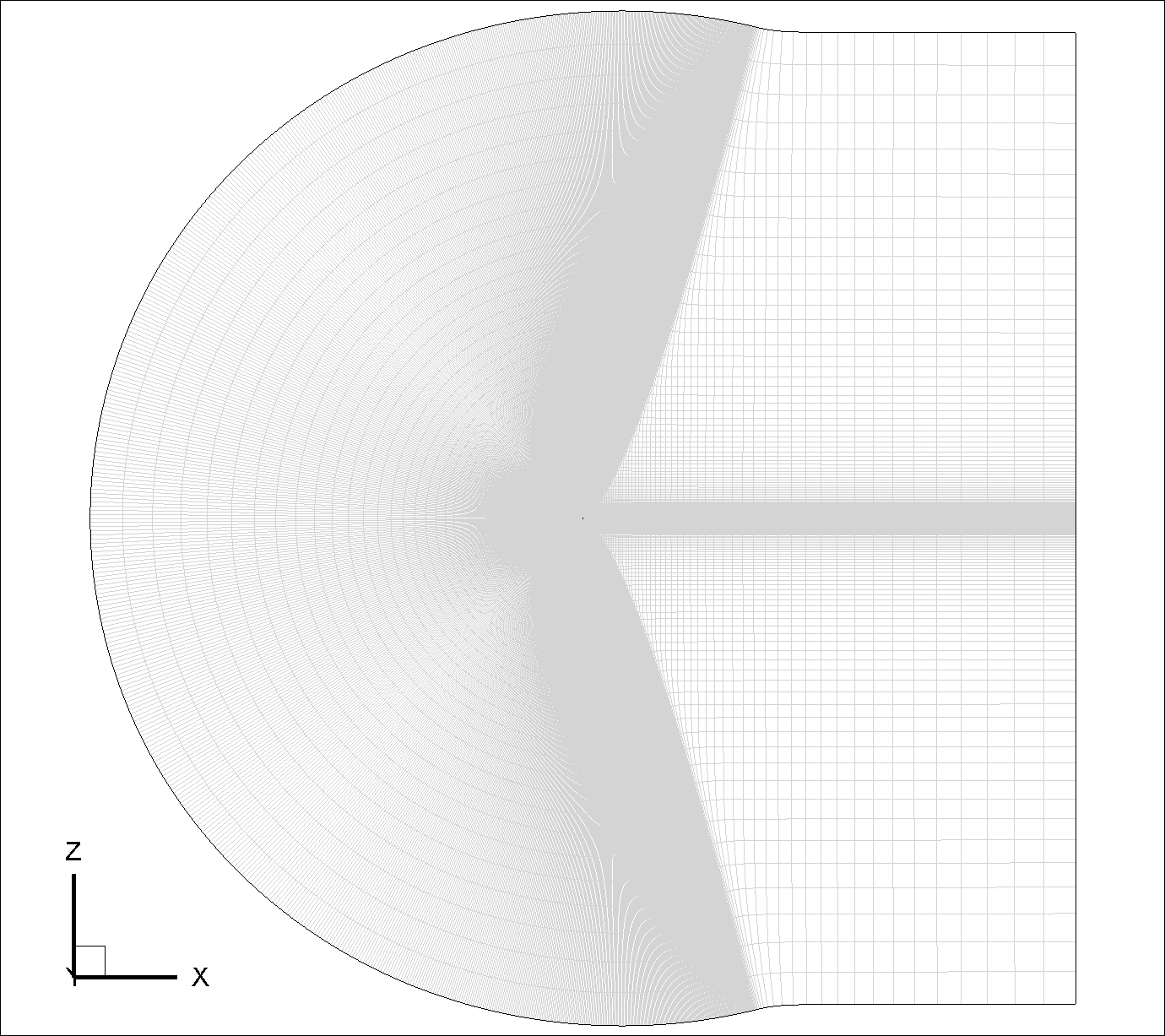
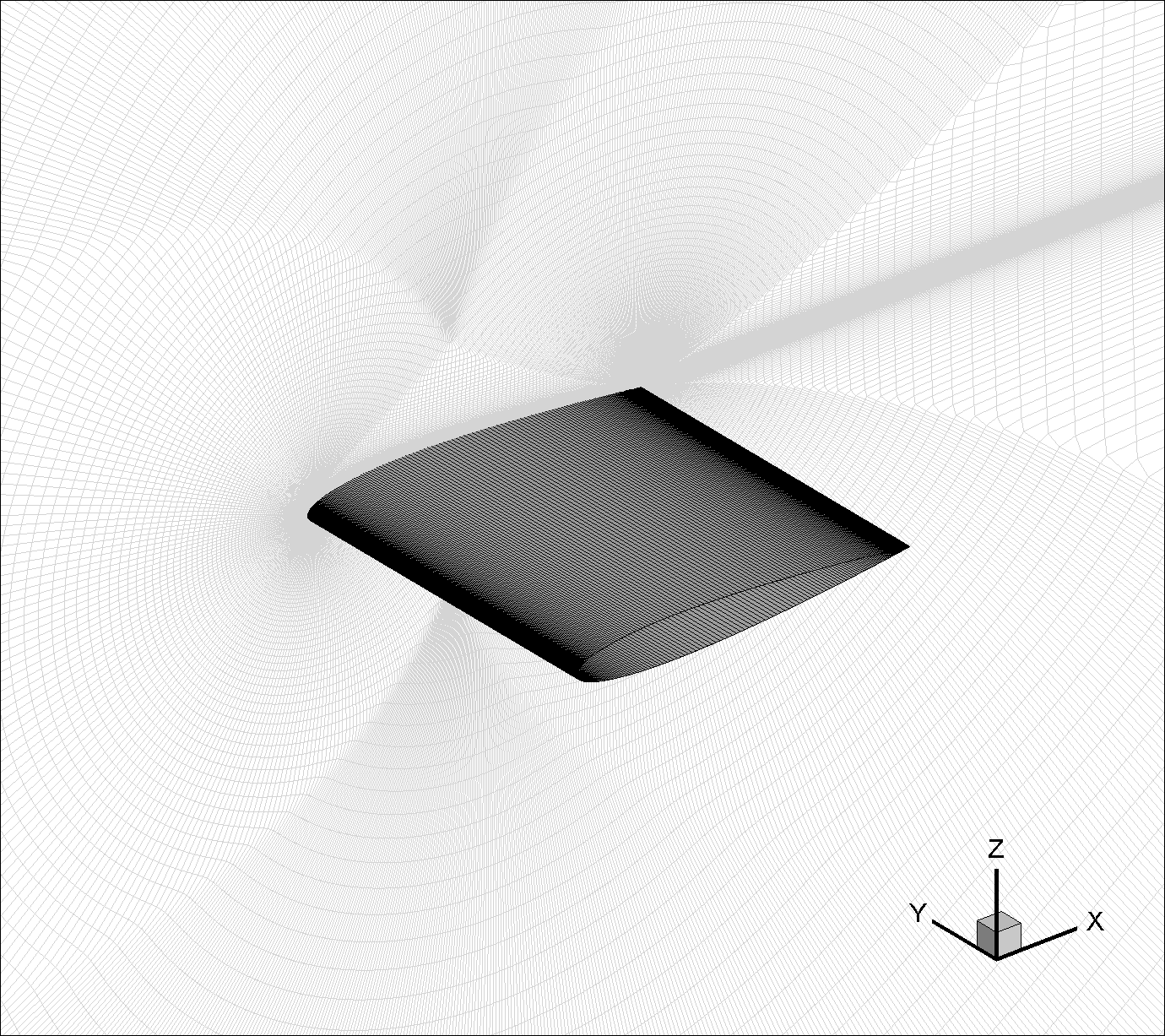
Fig. 16 Quasi-3D CFD model of NACA 0012 airfoil (Family II, Grid Level-4).#
As suggested by NASA-LaRC-TMR and ONERA-elsA, for this essentially incompressible flow, the freestream Mach number is
Parameters |
Units |
Values |
Notes |
|---|---|---|---|
Grid unit length |
|||
Reynolds number |
|||
Freestream Mach number |
|||
Reference temperature |
|||
Freestream turbulent viscosity ratio |
|||
default for SA model within Flow360 |
|||
the default value is |
|||
Angle of attack |
|||
CFL number |
|||
Residual convergence tolerance for NS equations |
|||
Residual convergence tolerance for SA/SST(m) equations |
|||
The “NoSlipWall” boundary condition is applied to the adiabatic viscous surface of the airfoil, and “SlipWall” is used as the symmetry condition in the spanwise direction. The “Freestream” boundary condition is utilized in the farfield, together with the default value of the freestream “turbulentViscosityRatio”, i.e.
Similarly, for the SST model, the value of
Steady-state solutions were computed iteratively, utilizing 2nd-order schemes for both the time averaged Navier-Stokes and the turbulence model equations. For the former, the CFL number was gradually ramped up to 100. Typically, the values of the absolute nonlinear residual convergence tolerances were set to be
SA/SA-RC Model Results#
Two-dimensional steady viscous mean flows past the NACA 0012 airfoil were simulated at the aforementioned operating conditions. Aerodynamic characteristics were visualized through contour plots of Mach number and turbulent viscosity ratio on the longitudinal cut-plane at
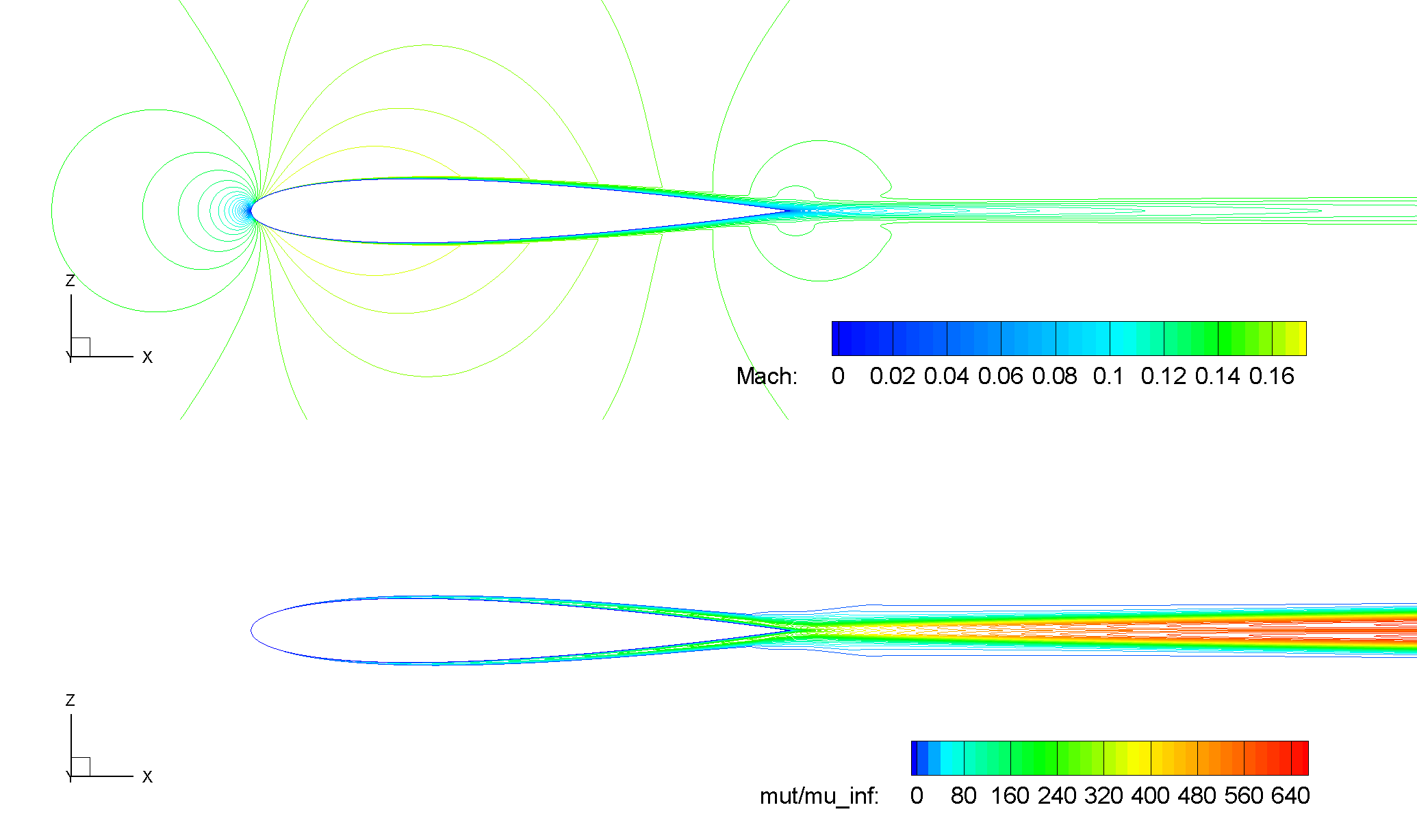
Fig. 17 Contours of Mach number and turbulent viscosity ratio, NACA 0012, SA-RC,
As seen from the above figure, for the zero lift condition at
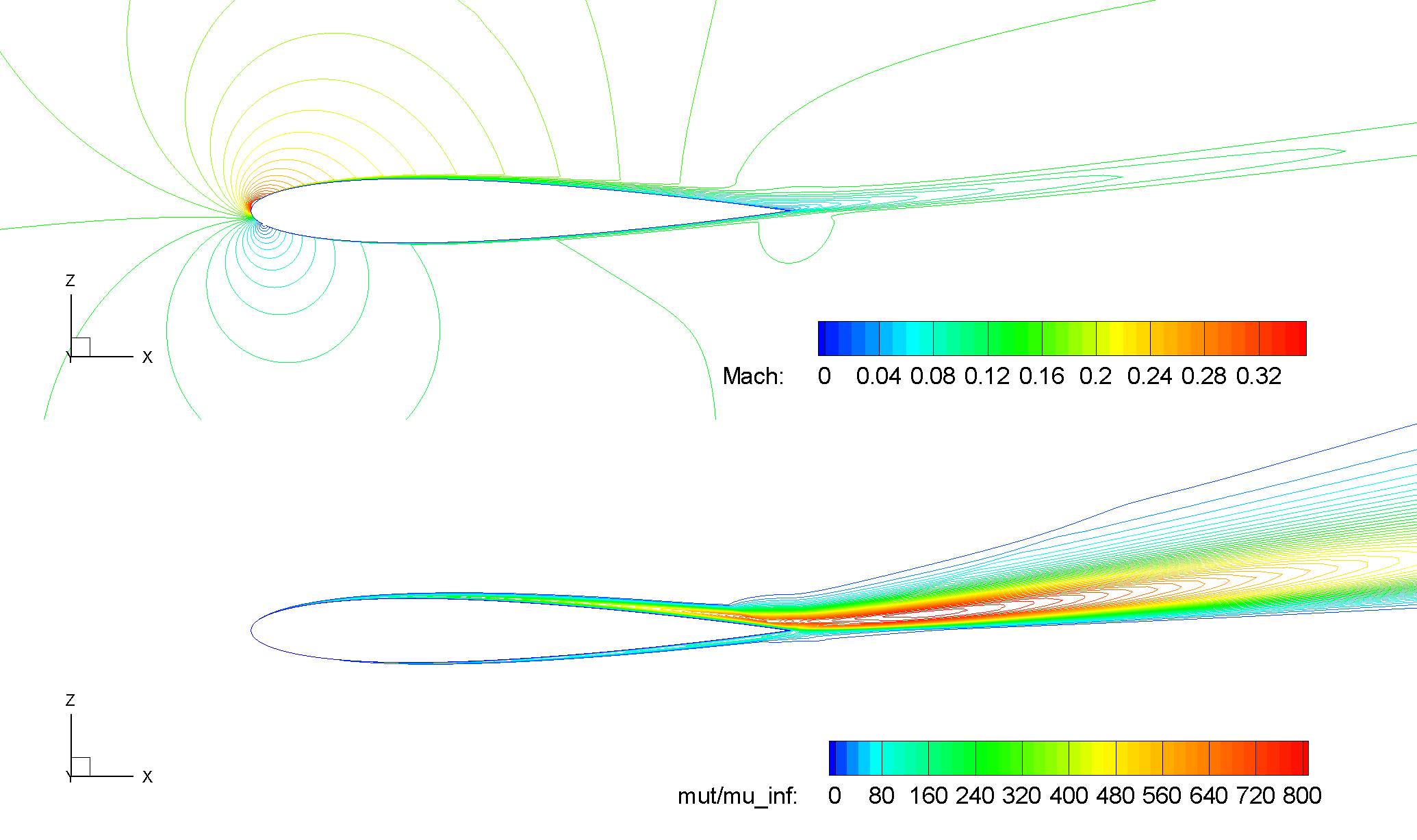
Fig. 18 Contours of Mach number and turbulent viscosity ratio, NACA 0012, SA-RC,
For a relatively high lift condition at
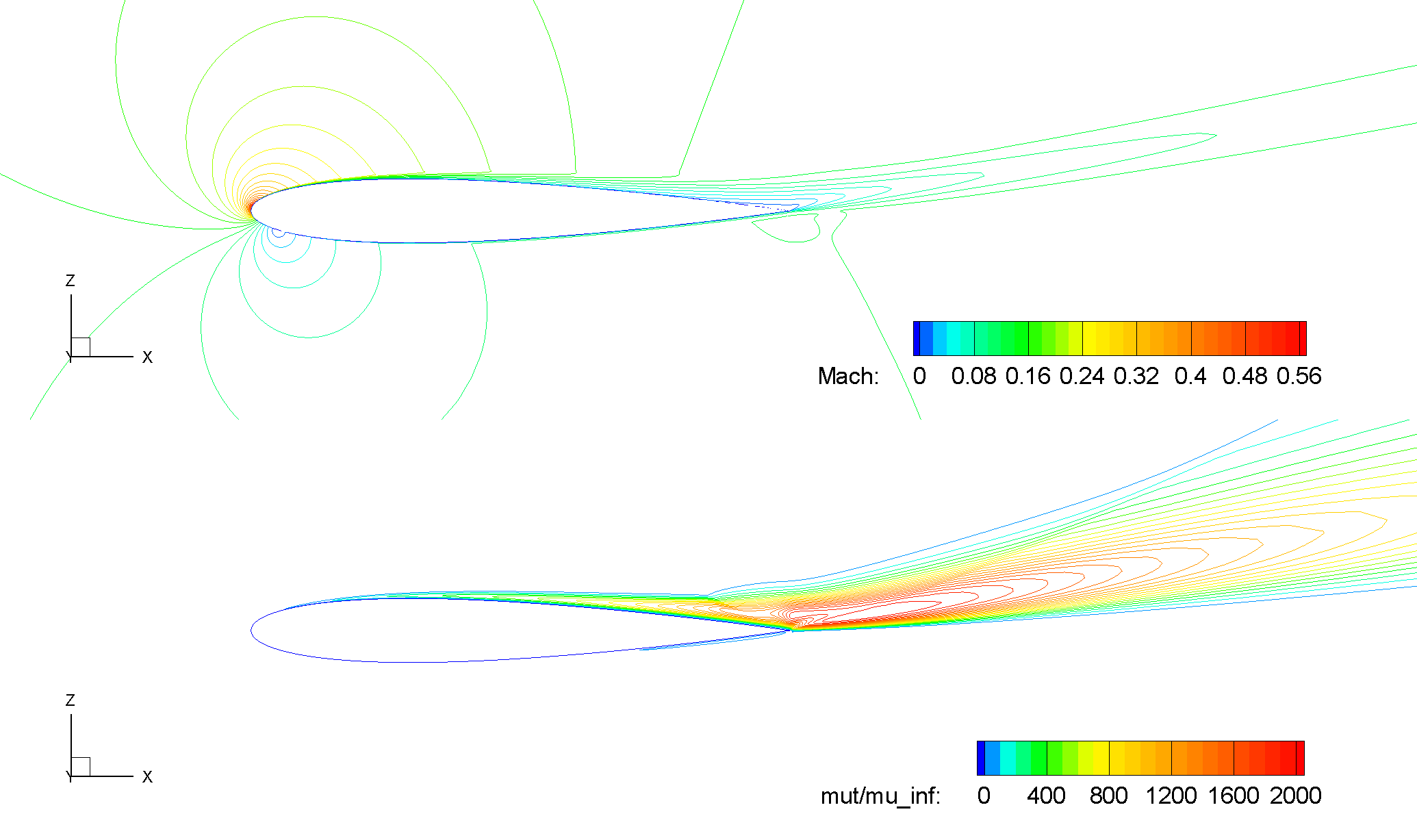
Fig. 19 Contours of Mach number and turbulent viscosity ratio, NACA 0012, SA-RC,
Also, as expected, at a higher angle of attack
For these operating conditions, surface distributions of pressure and skin friction coefficients, i.e.
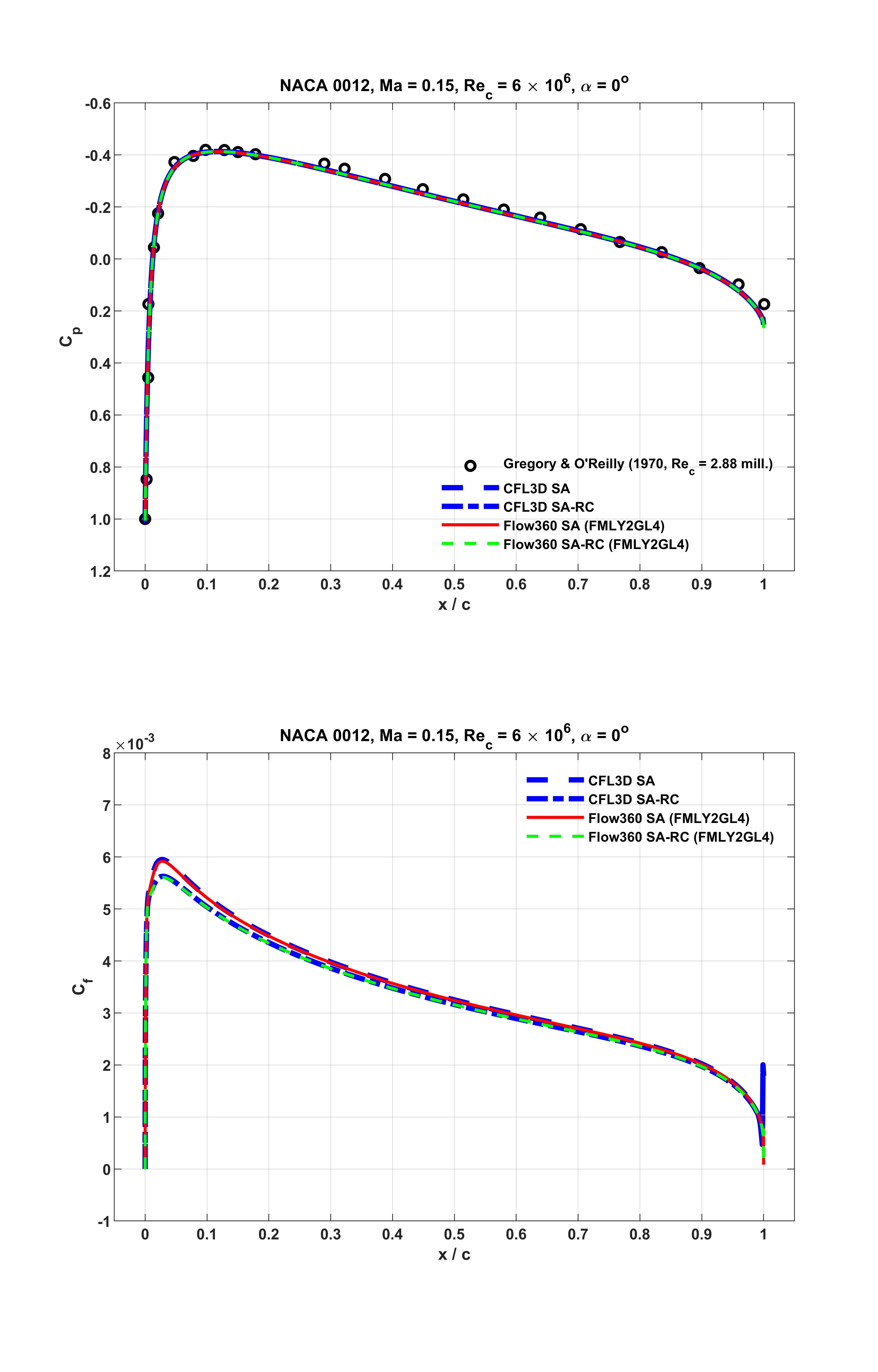
Fig. 20 Surface distributions of
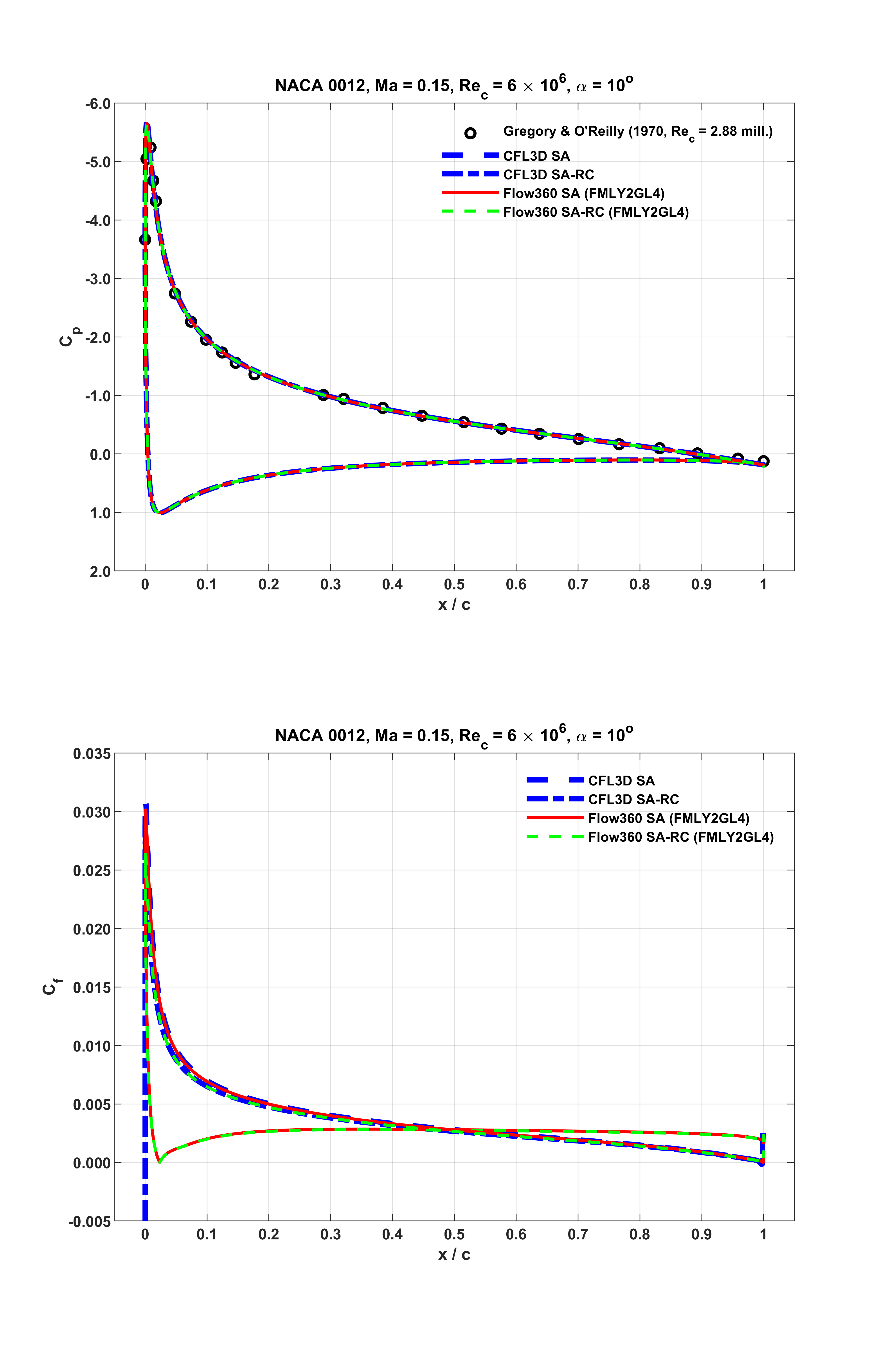
Fig. 21 Surface distributions of
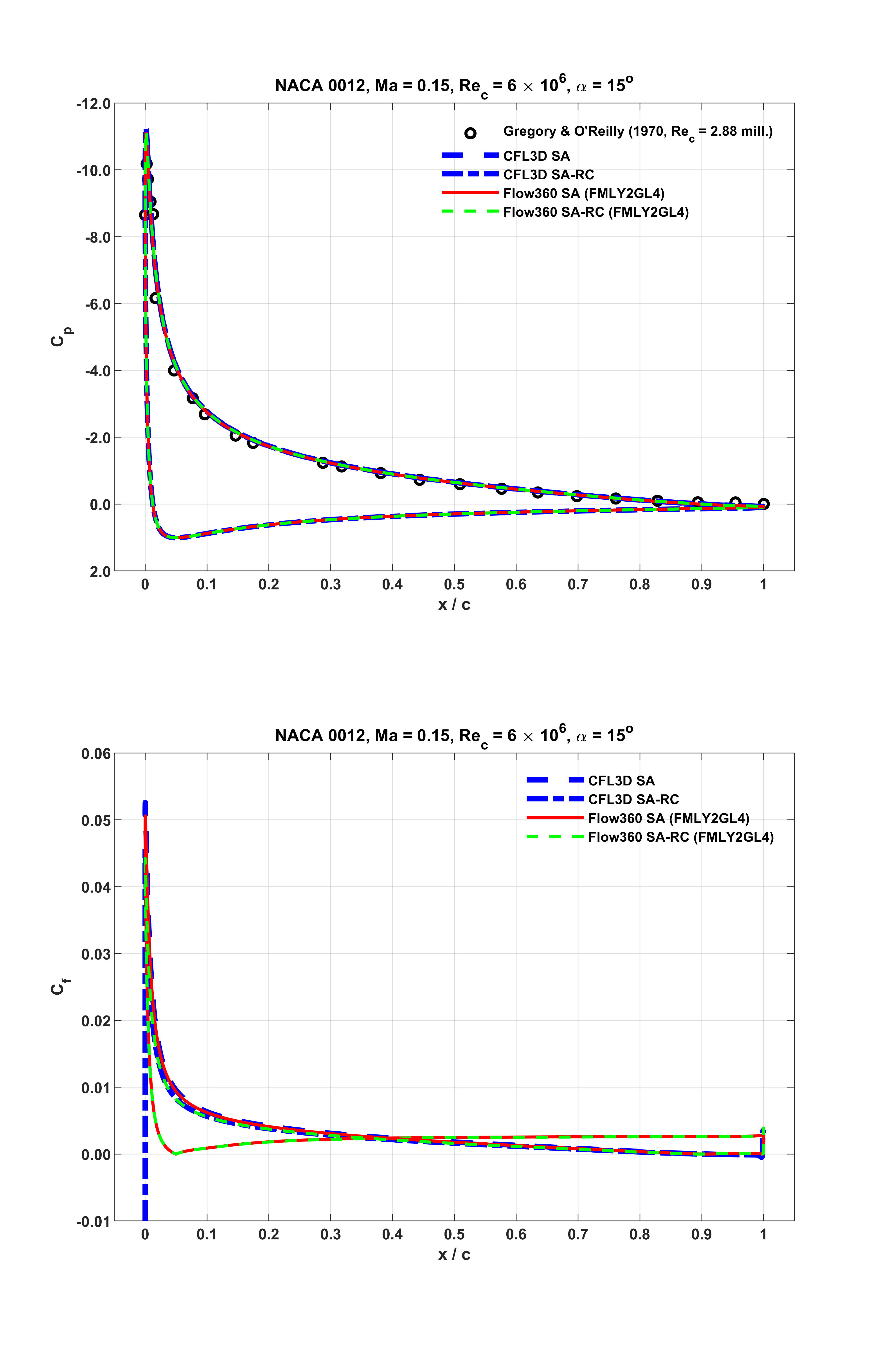
Fig. 22 Surface distributions of
As seen from the above figures, at all the three distinct lift conditions, Flow360 predictions accurately capture the experimental data, and closely match the counterparts of the reference numerical results. Notably, as shown in Fig. 22 associated with
The integrated
Codes |
Turb Mdl |
|||||
|---|---|---|---|---|---|---|
CFL3D |
SA |
0 |
-0.685E-05 |
0.00819 |
||
FUN3D |
SA |
0 |
0.00812 |
|||
NTS |
SA |
0 |
0.00813 |
|||
JOE |
SA |
0 |
0.00812 |
|||
SUMB |
SA |
0 |
0.00813 |
|||
TURNS |
SA |
0 |
0.00830 |
|||
GGNS |
SA |
0 |
0.00817 |
|||
OVERFLOW |
SA |
0 |
0.00838 |
|||
FLOW360 |
SA |
0 |
-8.648E-07 |
0.00808 |
0.006811 |
0.001267 |
CFL3D |
SA-RC |
0 |
-0.717E-05 |
0.00793 |
||
FUN3D |
SA-RC |
0 |
0.00790 |
|||
NTS |
SA-RC |
0 |
0.00792 |
|||
FLOW360 |
SA-RC |
0 |
-7.960E-07 |
0.00787 |
0.006611 |
0.001256 |
It is noted that, for some of these representative aerodynamic quantities, the results of Flow360 are at either the upper or the lower bounds of the reference intervals. It is suspected that this is due to the differences in the discretization, such as node-centered or cell-centered schemes, as well as convergence criteria, at least as seen from the
Codes |
Turb Mdl |
|||||
|---|---|---|---|---|---|---|
CFL3D |
SA |
10 |
1.0909 |
0.01231 |
||
FUN3D |
SA |
10 |
1.0983 |
0.01242 |
||
NTS |
SA |
10 |
1.0891 |
0.01243 |
||
JOE |
SA |
10 |
1.0918 |
0.01245 |
||
SUMB |
SA |
10 |
1.0904 |
0.01233 |
||
TURNS |
SA |
10 |
1.1000 |
0.01230 |
||
GGNS |
SA |
10 |
1.0941 |
0.01225 |
||
OVERFLOW |
SA |
10 |
1.0990 |
0.01251 |
||
FLOW360 |
SA |
10 |
1.0889 |
0.01244 |
0.006148 |
0.006292 |
CFL3D |
SA-RC |
10 |
1.0947 |
0.01179 |
||
FUN3D |
SA-RC |
10 |
1.1020 |
0.01191 |
||
NTS |
SA-RC |
10 |
1.0933 |
0.01193 |
||
FLOW360 |
SA-RC |
10 |
1.0917 |
0.01193 |
0.005851 |
0.006079 |
CFL3D(TMNA, noPV) |
SA |
10 |
1.0896 |
0.01240 |
0.006203 |
0.006200 |
FUN3D(TMNA, noPV) |
SA |
10 |
1.0910 |
0.01239 |
0.006206 |
0.006179 |
TAU(TMNA, noPV) |
SA |
10 |
1.0905 |
0.01233 |
0.006216 |
0.006117 |
Importantly, a different computational grid with substantially finer trailing edge streamwise spacing is used for the current cases. As described on the NASA webpage, before June 23, 2014, there was a typo in the slightly scaled version of the formula that was used to generate the NACA 0012 airfoil profile. This caused a slight non-closure of the order of
Since the typo discovered, thorough high-accuracy numerical analysis had been performed to reveal scenarios such as grid convergence, etc. Details of these updated investigations are given on this turbulence model numerical analysis (TMNA) webpage of NASA, as well as the ONERA-elsA webpage. These updated data of
Codes |
Turb Mdl |
|||||
|---|---|---|---|---|---|---|
CFL3D |
SA |
15 |
1.5461 |
0.02124 |
||
FUN3D |
SA |
15 |
1.5547 |
0.02159 |
||
NTS |
SA |
15 |
1.5461 |
0.02105 |
||
JOE |
SA |
15 |
1.5490 |
0.02148 |
||
SUMB |
SA |
15 |
1.5446 |
0.02141 |
||
TURNS |
SA |
15 |
1.5642 |
0.02140 |
||
GGNS |
SA |
15 |
1.5576 |
0.02073 |
||
OVERFLOW |
SA |
15 |
1.5576 |
0.02149 |
||
FLOW360 |
SA |
15 |
1.5381 |
0.02158 |
0.005112 |
0.016473 |
CFL3D |
SA-RC |
15 |
1.5560 |
0.02066 |
||
FUN3D |
SA-RC |
15 |
1.5651 |
0.02099 |
||
NTS |
SA-RC |
15 |
1.5562 |
0.02043 |
||
FLOW360 |
SA-RC |
15 |
1.5467 |
0.02100 |
0.004707 |
0.016288 |
The corresponding
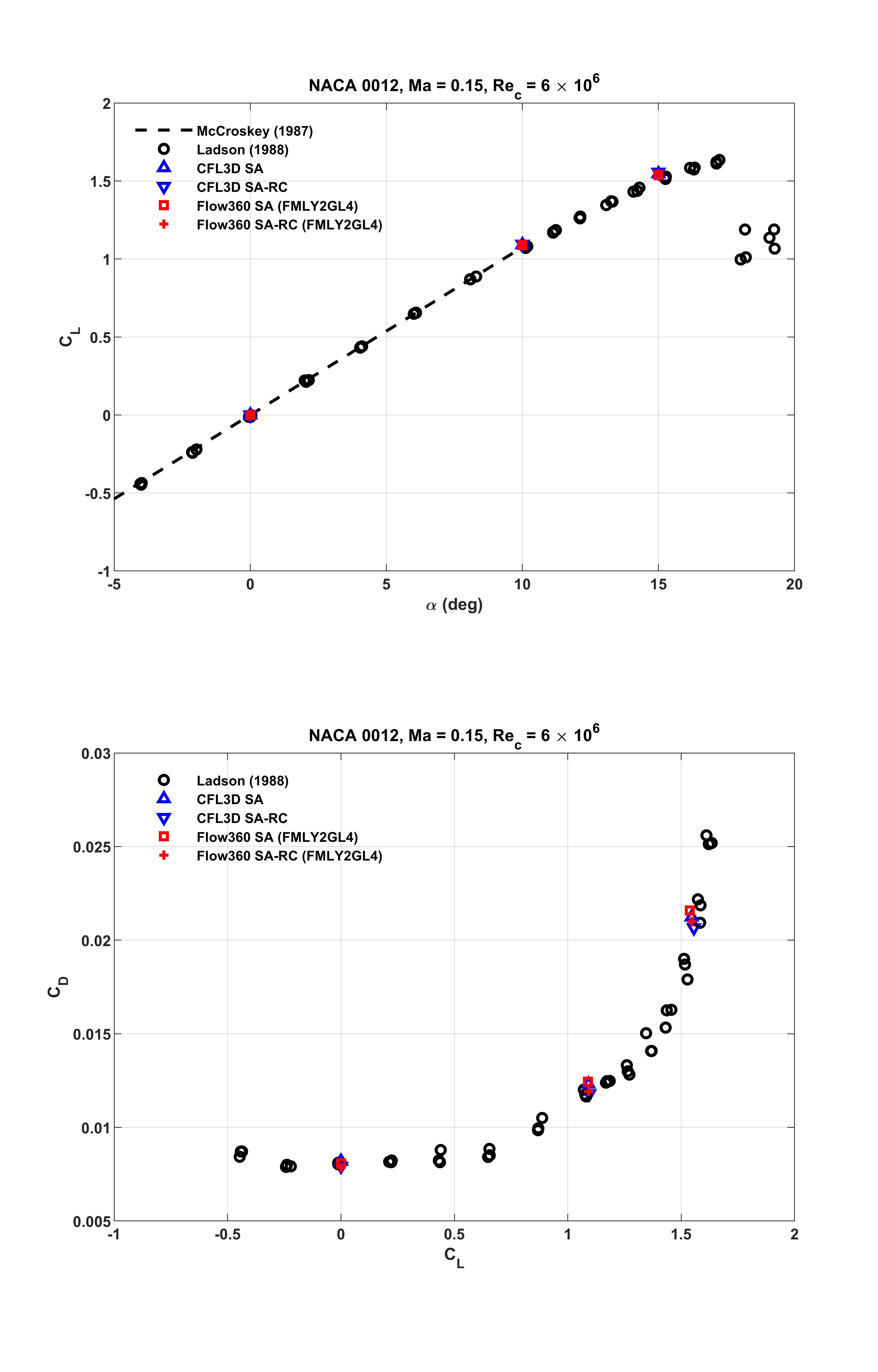
Fig. 23 Comparisons of
SST(m) Model Results#
Similar to the above sub-section, Flow360 results computed with the SST(m) model are examined in this sub-section. Aerodynamic characteristics were visualized through contour plots of Mach number and turbulent viscosity ratio on the longitudinal cut-plane at
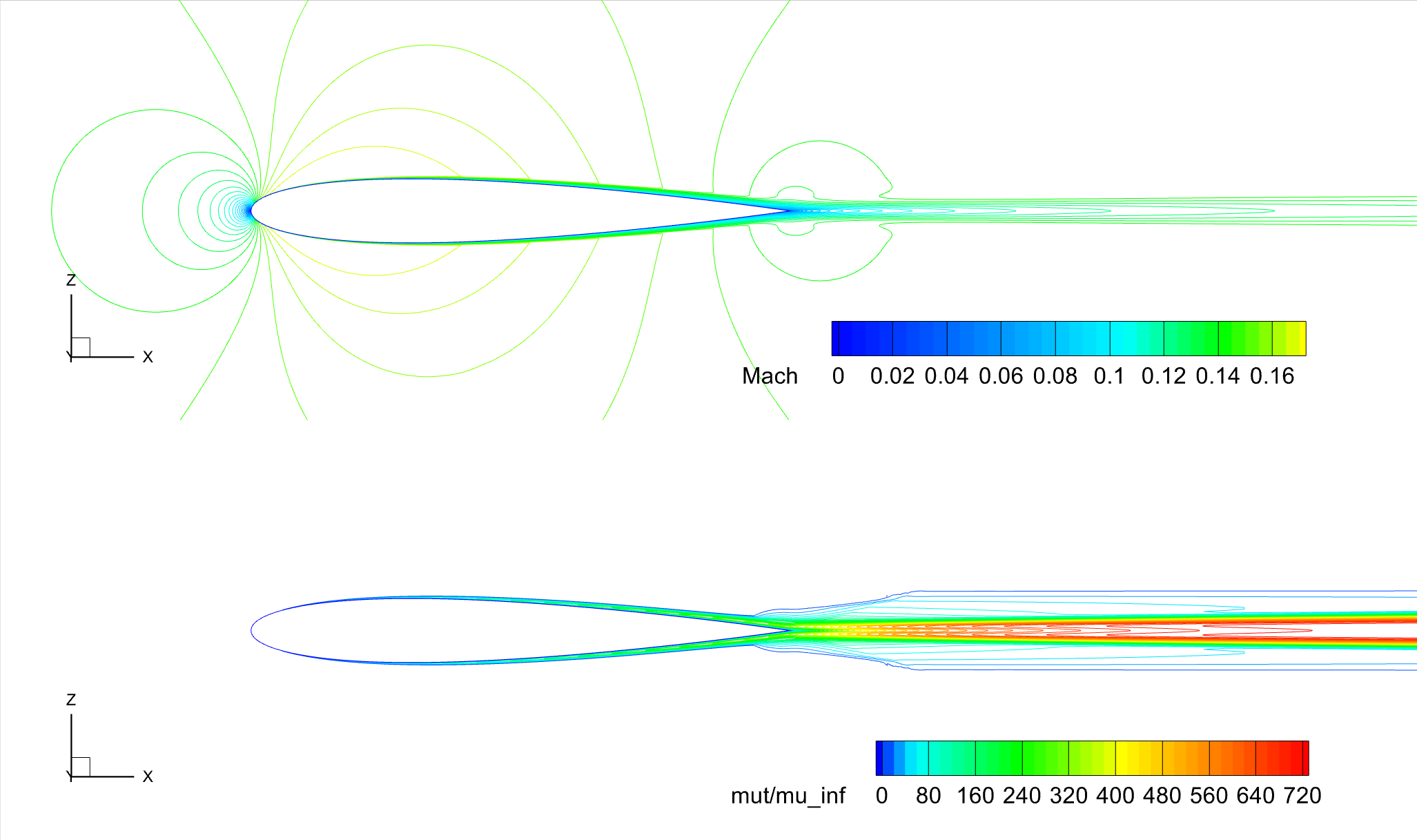
Fig. 24 Contours of Mach number and turbulent viscosity ratio, NACA 0012, SST(m),
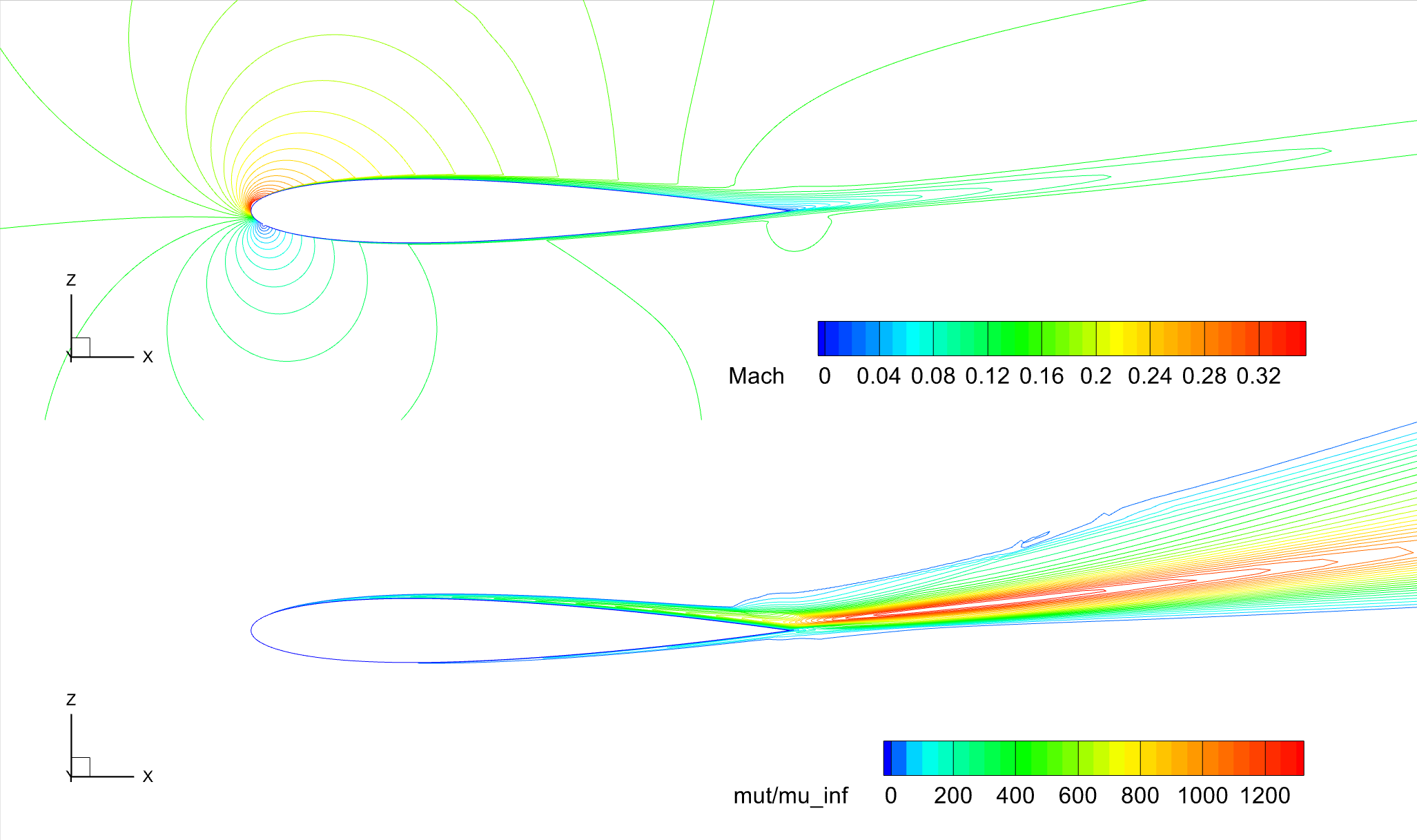
Fig. 25 Contours of Mach number and turbulent viscosity ratio, NACA 0012, SST(m),
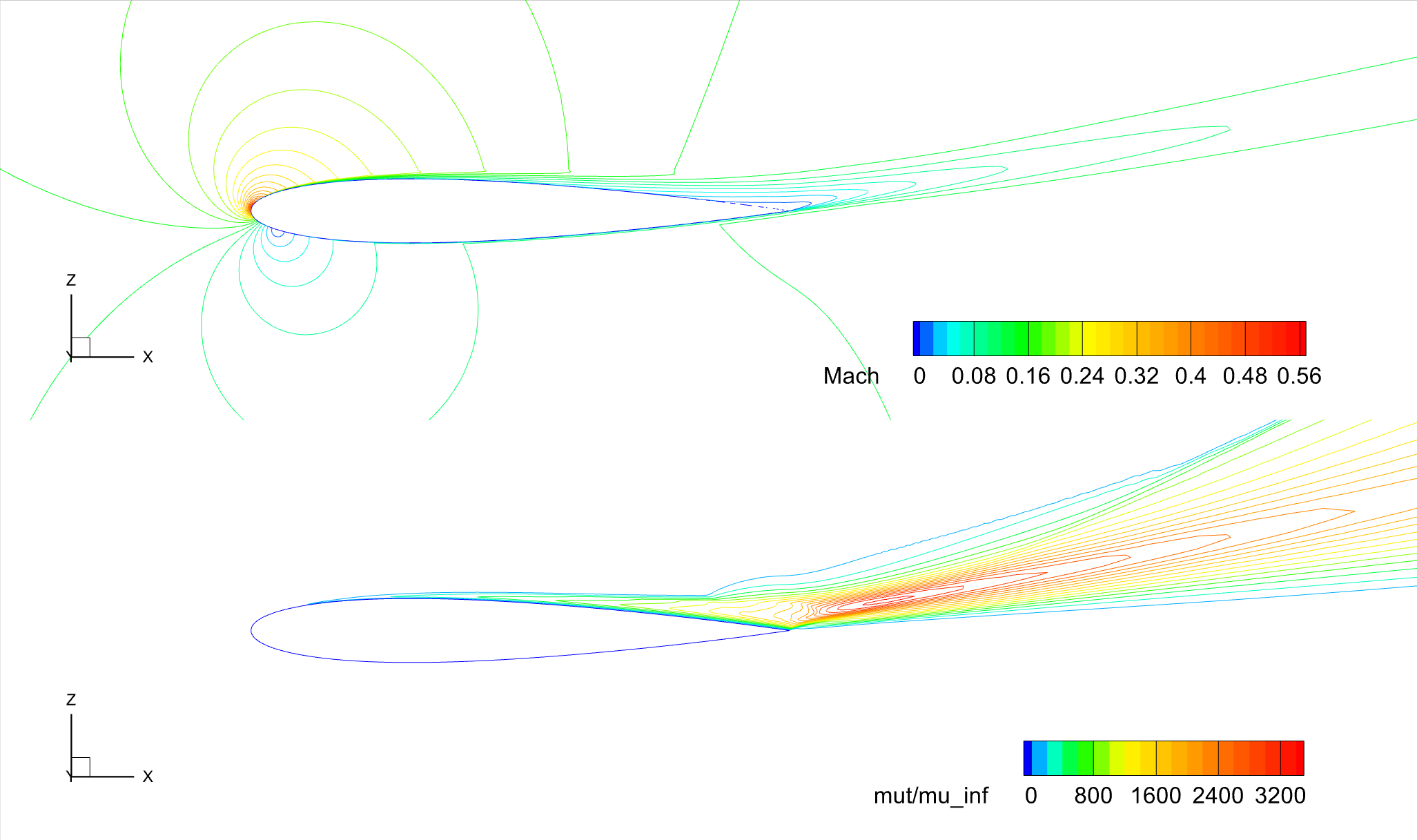
Fig. 26 Contours of Mach number and turbulent viscosity ratio, NACA 0012, SST(m),
For these operating conditions, surface distributions of pressure and skin friction coefficients are examined in Fig. 27, Fig. 28 and Fig. 29, with respect to reference data. In these figures, Flow360 results are indicated as the red solid lines. The corresponding CFL3D results are shown as the blue dashed lines. Also, in these figures, experimental data are given as symbols. These are the same measurements of
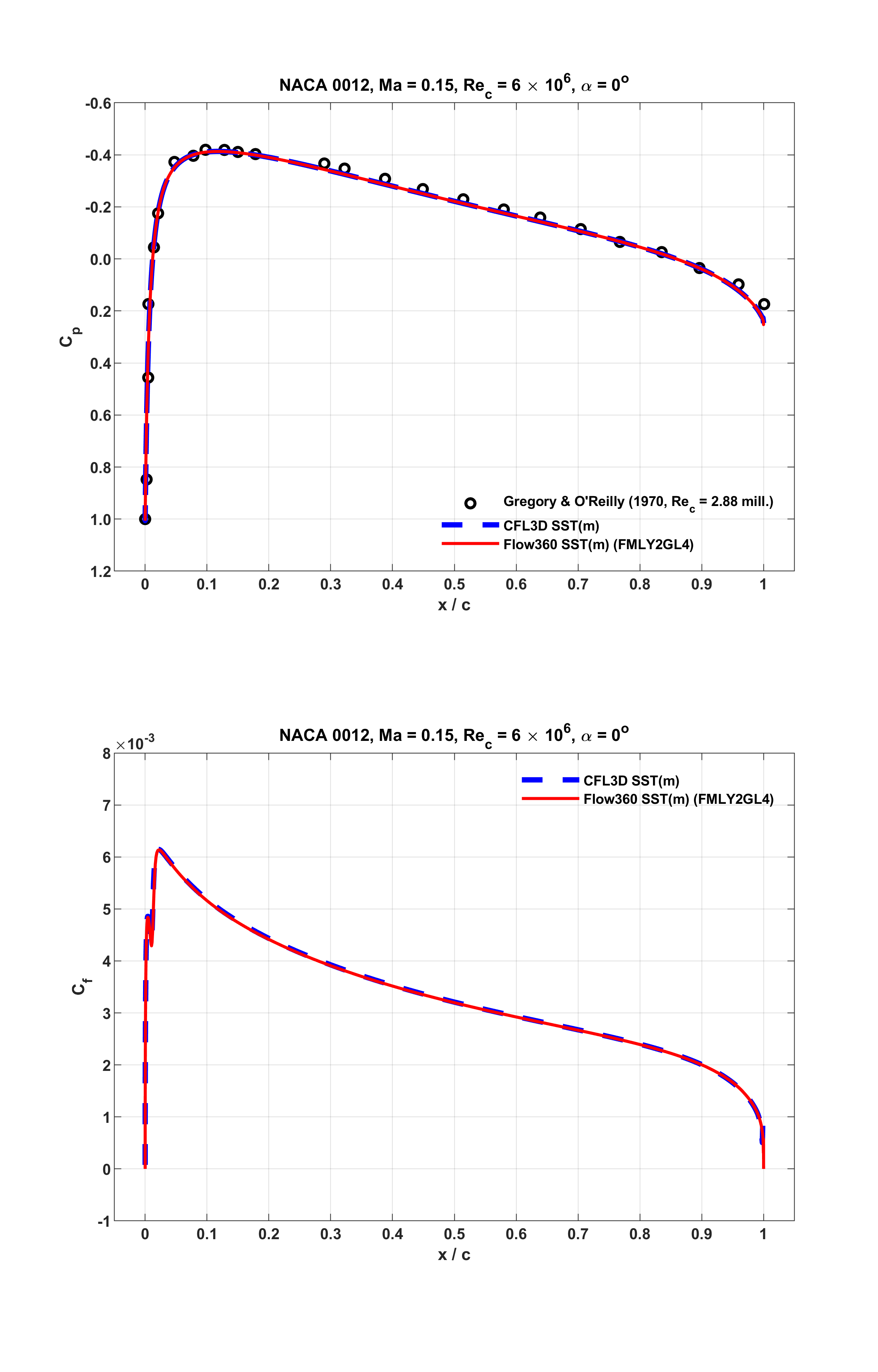
Fig. 27 Surface distributions of
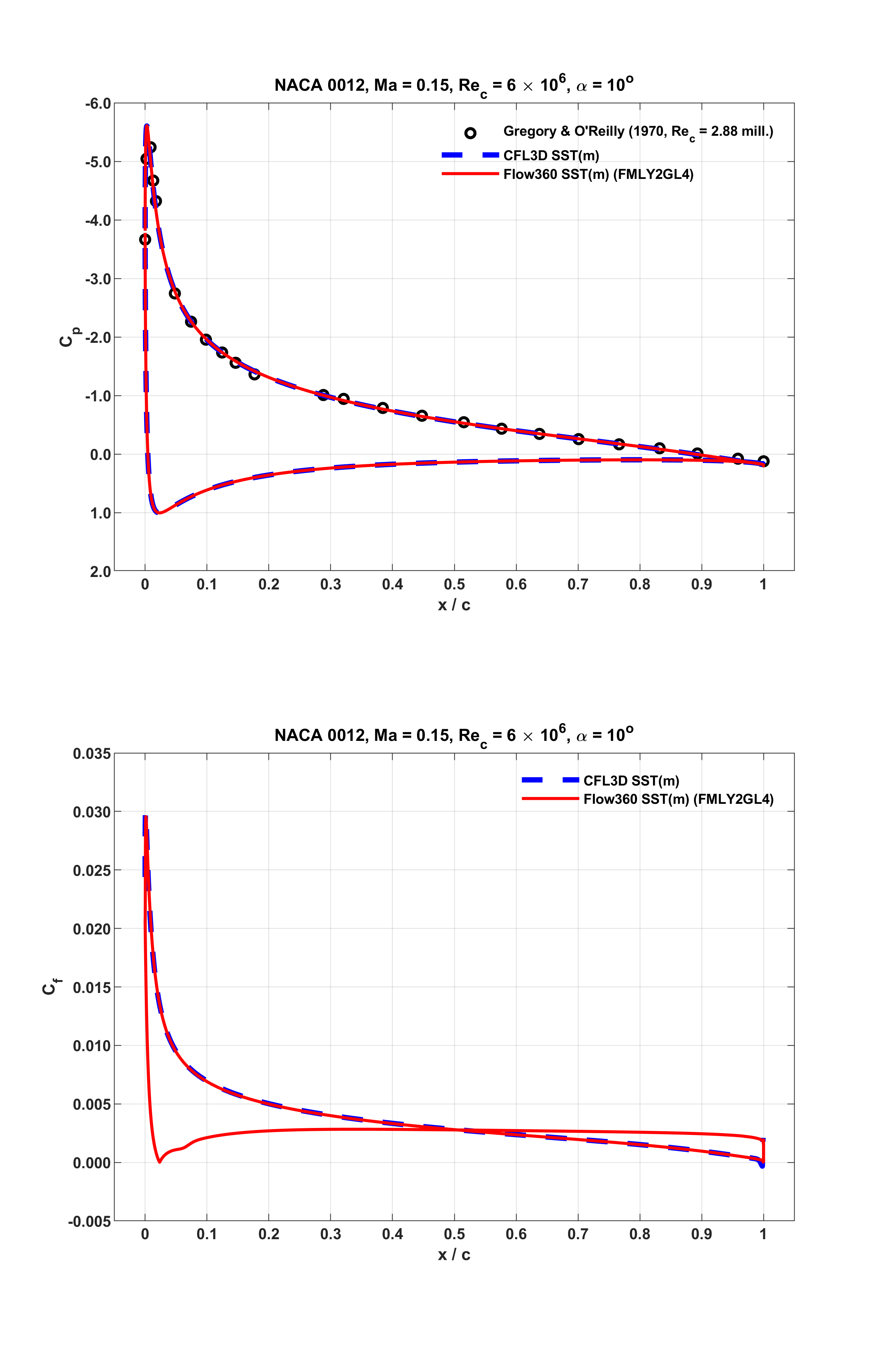
Fig. 28 Surface distributions of
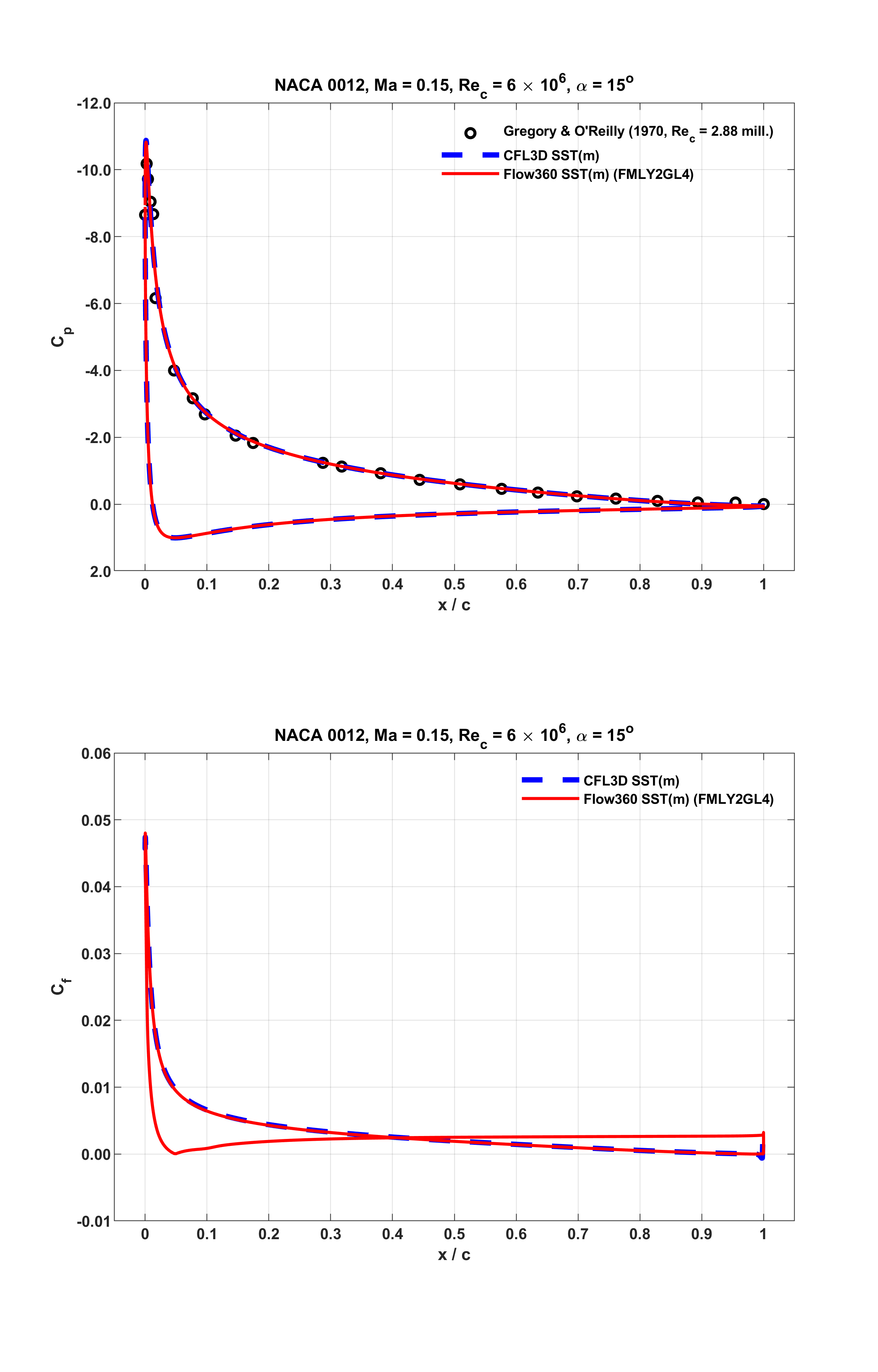
Fig. 29 Surface distributions of
As seen from the above figures, at all the three distinct lift conditions, Flow360 predictions accurately capture the experimental data, and closely match CFL3D results. Notably, as shown in Fig. 29 associated with
The integrated
Codes |
Turb Mdl |
|||||
|---|---|---|---|---|---|---|
CFL3D |
SST(m) |
0 |
-0.763E-05 |
0.00809 |
||
FUN3D |
SST(m) |
0 |
0.00808 |
|||
NTS |
SST(m) |
0 |
0.00809 |
|||
OVERFLOW |
SST |
0 |
0.00821 |
|||
FLOW360 |
SST(m) |
0 |
8.704E-06 |
0.00803 |
0.006724 |
0.001301 |
CFL3D |
SST(m) |
10 |
1.0778 |
0.01236 |
||
FUN3D |
SST(m) |
10 |
1.0840 |
0.01253 |
||
NTS |
SST(m) |
10 |
1.0765 |
0.01251 |
||
OVERFLOW |
SST |
10 |
1.0847 |
0.01262 |
||
FLOW360 |
SST(m) |
10 |
1.0800 |
0.01256 |
0.006141 |
0.006417 |
CFL3D |
SST(m) |
15 |
1.5068 |
0.02219 |
||
FUN3D |
SST(m) |
15 |
1.5109 |
0.02275 |
||
NTS |
SST(m) |
15 |
1.5100 |
0.02187 |
||
OVERFLOW |
SST |
15 |
1.5094 |
0.02288 |
||
FLOW360 |
SST(m) |
15 |
1.5022 |
0.02300 |
0.005222 |
0.017777 |
The corresponding
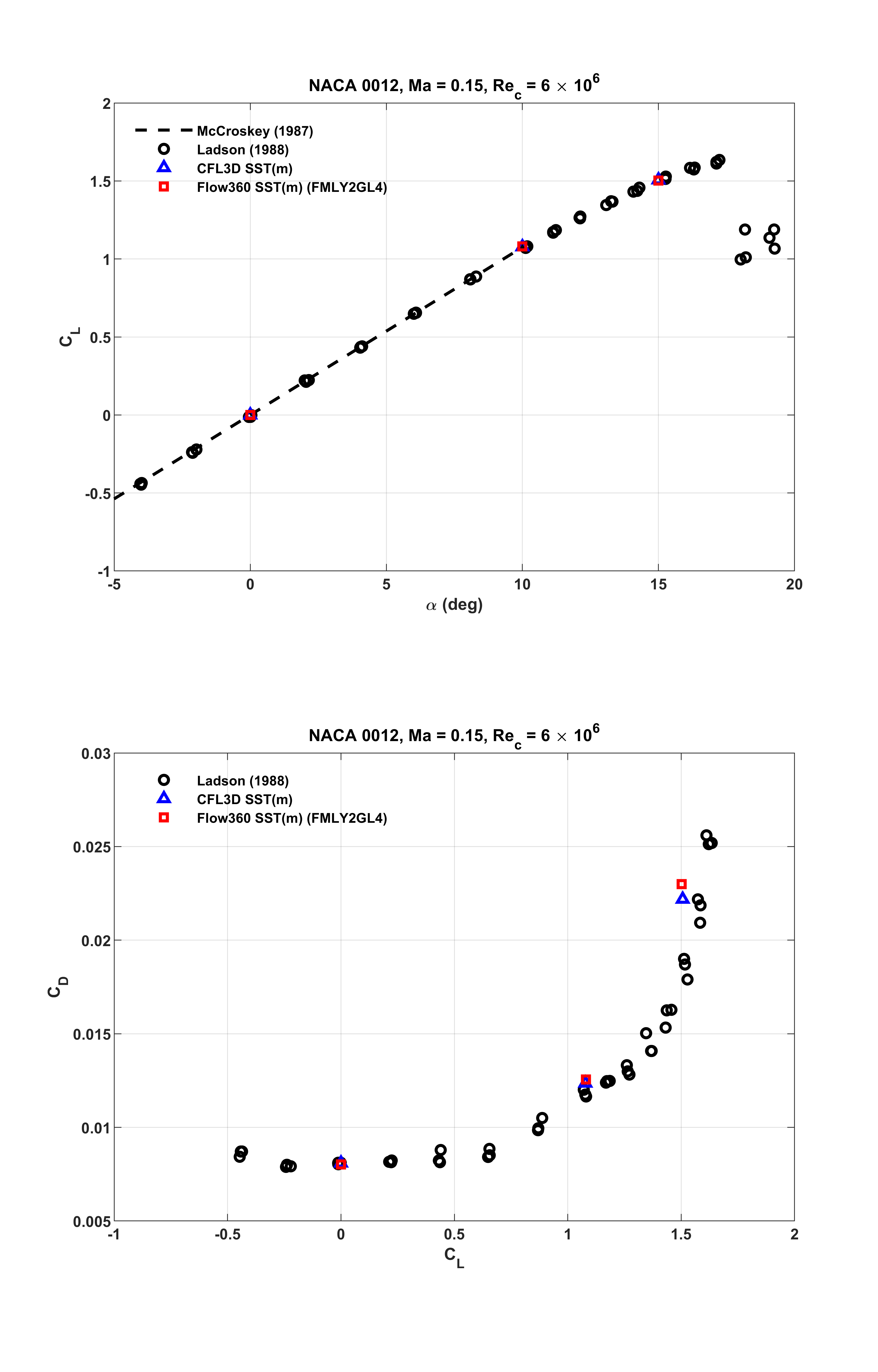
Fig. 30 Comparisons of
Remarks#
Through this validation study, the flow field, the surface data and the representative aerodynamic quantities predicted by Flow360 were carefully examined. With respect to the latest reference numerical results computed on the same grid as used here, the available agreement on